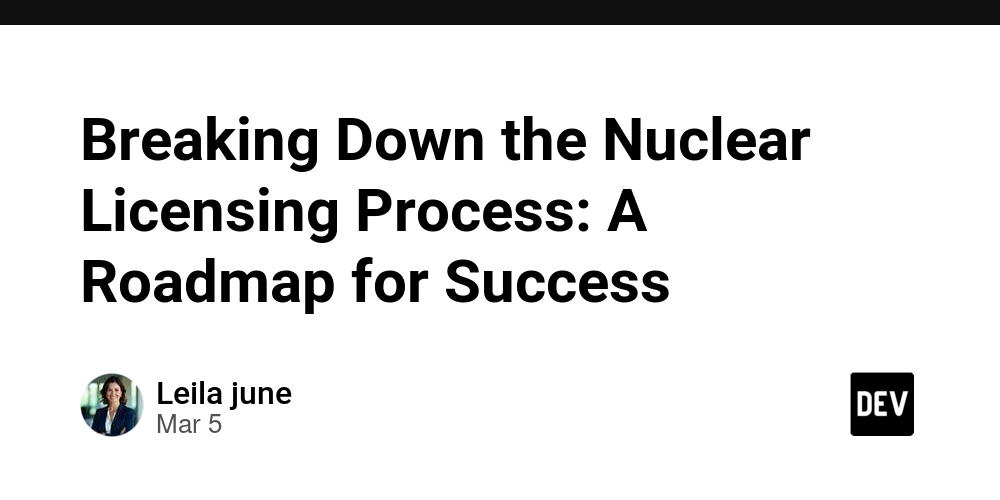Breaking Down the Nuclear Licensing Process: A Roadmap for Success
The nuclear licensing process is a critical step for any organization seeking to build, operate, or modify a nuclear facility. This process ensures that nuclear operations meet strict safety, security, and environmental standards. Understanding the steps involved and preparing accordingly can make the difference between success and costly delays. In this article, we will break down the nuclear licensing process, discuss key regulatory requirements, and provide a roadmap for success. We will also highlight how Nuclear Licensing and Regulatory Support from experts like Certrec can simplify the process and help organizations achieve compliance efficiently. Understanding the Nuclear Licensing Process The nuclear licensing process is a structured framework established by regulatory authorities such as the U.S. Nuclear Regulatory Commission (NRC). This framework ensures that nuclear facilities operate safely and do not pose undue risks to public health or the environment. Why Is Nuclear Licensing Important? Ensures compliance with national and international regulations Protects public health and safety Maintains environmental sustainability Prevents legal and financial penalties Builds public and stakeholder confidence in nuclear operations Key Regulatory Agencies Different countries have their own regulatory agencies overseeing nuclear safety. Some of the most recognized authorities include: United States: Nuclear Regulatory Commission (NRC) Canada: Canadian Nuclear Safety Commission (CNSC) United Kingdom: Office for Nuclear Regulation (ONR) International Oversight: International Atomic Energy Agency (IAEA) Steps in the Nuclear Licensing Process The licensing process can be complex, involving multiple stages. Below is a step-by-step breakdown of the typical nuclear licensing roadmap. 1. Pre-Application Phase Before officially applying for a license, nuclear facility operators must conduct thorough planning and feasibility studies. This phase includes: Identifying site suitability and environmental impact considerations Conducting preliminary risk assessments Engaging with regulators for early guidance Consulting experts in Nuclear Licensing and Regulatory Support, such as Certrec, to streamline the process 2. License Application Submission Once the initial planning is complete, applicants submit a formal nuclear license application, which includes: Safety Analysis Report (SAR): Demonstrates how the facility will manage risks and ensure safety. Environmental Impact Statement (EIS): Evaluates the potential environmental consequences of the project. Security and Emergency Preparedness Plan: Outlines the measures in place for emergency situations. 3. Regulatory Review and Public Consultation Regulatory bodies conduct detailed technical and safety reviews to assess compliance. This phase may include: Public hearings to address community concerns Requests for additional information from applicants Independent expert assessments 4. Construction and Operating License Approval Once the regulatory body is satisfied with the application, they issue the necessary licenses: Construction Permit: Authorizes the facility to begin construction. Operating License: Grants permission to start operations after successful inspections. 5. Periodic Inspections and Compliance Monitoring After obtaining an operating license, nuclear facilities are subject to ongoing inspections to ensure compliance. These include: Routine safety audits Environmental monitoring Security evaluations Regulatory reporting 6. License Renewal or Decommissioning Nuclear licenses are valid for a fixed period, after which operators must either: Apply for license renewal, demonstrating continued compliance. Proceed with decommissioning, safely shutting down the facility and managing nuclear waste disposal. Challenges in Nuclear Licensing Despite its structured nature, the nuclear licensing process presents several challenges: 1. Regulatory Complexity Navigating nuclear licensing regulations requires extensive expertise. Different jurisdictions have unique requirements, making it essential to seek Nuclear Licensing and Regulatory Support from experienced professionals like Certrec. 2. Lengthy Approval Timelines Obtaining a nuclear license can take several years, depending on project size and regulatory scrutiny. Delays can arise due to: Incomplete applications Changing regulations Public opposition Insufficient technical documentation 3. High Compliance Costs The cost of meeting regulatory standards is substantial. Financial planning and expert assistance are crucial to avoid unexpected expenses. 4. Public and Stakeholder Engagement Public perception of nuclear energy can influence licens

The nuclear licensing process is a critical step for any organization seeking to build, operate, or modify a nuclear facility. This process ensures that nuclear operations meet strict safety, security, and environmental standards. Understanding the steps involved and preparing accordingly can make the difference between success and costly delays.
In this article, we will break down the nuclear licensing process, discuss key regulatory requirements, and provide a roadmap for success. We will also highlight how Nuclear Licensing and Regulatory Support from experts like Certrec can simplify the process and help organizations achieve compliance efficiently.
Understanding the Nuclear Licensing Process
The nuclear licensing process is a structured framework established by regulatory authorities such as the U.S. Nuclear Regulatory Commission (NRC). This framework ensures that nuclear facilities operate safely and do not pose undue risks to public health or the environment.
Why Is Nuclear Licensing Important?
- Ensures compliance with national and international regulations
- Protects public health and safety
- Maintains environmental sustainability
- Prevents legal and financial penalties
- Builds public and stakeholder confidence in nuclear operations
Key Regulatory Agencies
Different countries have their own regulatory agencies overseeing nuclear safety. Some of the most recognized authorities include:
- United States: Nuclear Regulatory Commission (NRC)
- Canada: Canadian Nuclear Safety Commission (CNSC)
- United Kingdom: Office for Nuclear Regulation (ONR)
- International Oversight: International Atomic Energy Agency (IAEA)
Steps in the Nuclear Licensing Process
The licensing process can be complex, involving multiple stages. Below is a step-by-step breakdown of the typical nuclear licensing roadmap.
1. Pre-Application Phase
Before officially applying for a license, nuclear facility operators must conduct thorough planning and feasibility studies. This phase includes:
- Identifying site suitability and environmental impact considerations
- Conducting preliminary risk assessments
- Engaging with regulators for early guidance
- Consulting experts in Nuclear Licensing and Regulatory Support, such as Certrec, to streamline the process
2. License Application Submission
Once the initial planning is complete, applicants submit a formal nuclear license application, which includes:
- Safety Analysis Report (SAR): Demonstrates how the facility will manage risks and ensure safety.
- Environmental Impact Statement (EIS): Evaluates the potential environmental consequences of the project.
- Security and Emergency Preparedness Plan: Outlines the measures in place for emergency situations.
3. Regulatory Review and Public Consultation
Regulatory bodies conduct detailed technical and safety reviews to assess compliance. This phase may include:
- Public hearings to address community concerns
- Requests for additional information from applicants
- Independent expert assessments
4. Construction and Operating License Approval
Once the regulatory body is satisfied with the application, they issue the necessary licenses:
- Construction Permit: Authorizes the facility to begin construction.
- Operating License: Grants permission to start operations after successful inspections.
5. Periodic Inspections and Compliance Monitoring
After obtaining an operating license, nuclear facilities are subject to ongoing inspections to ensure compliance. These include:
- Routine safety audits
- Environmental monitoring
- Security evaluations
- Regulatory reporting
6. License Renewal or Decommissioning
Nuclear licenses are valid for a fixed period, after which operators must either:
- Apply for license renewal, demonstrating continued compliance.
- Proceed with decommissioning, safely shutting down the facility and managing nuclear waste disposal.
Challenges in Nuclear Licensing
Despite its structured nature, the nuclear licensing process presents several challenges:
1. Regulatory Complexity
Navigating nuclear licensing regulations requires extensive expertise. Different jurisdictions have unique requirements, making it essential to seek Nuclear Licensing and Regulatory Support from experienced professionals like Certrec.
2. Lengthy Approval Timelines
Obtaining a nuclear license can take several years, depending on project size and regulatory scrutiny. Delays can arise due to:
- Incomplete applications
- Changing regulations
- Public opposition
- Insufficient technical documentation
3. High Compliance Costs
The cost of meeting regulatory standards is substantial. Financial planning and expert assistance are crucial to avoid unexpected expenses.
4. Public and Stakeholder Engagement
Public perception of nuclear energy can influence licensing decisions. Effective communication and transparency help build trust and support.
How Certrec Supports Nuclear Licensing Success
Certrec is a leader in Nuclear Licensing and Regulatory Support, offering a comprehensive suite of services to simplify the nuclear licensing process. Their expertise helps organizations:
- Prepare and submit accurate license applications
- Navigate regulatory requirements efficiently
- Address compliance challenges and minimize delays
- Conduct safety assessments and environmental reviews
- Manage ongoing regulatory interactions and inspections
With decades of experience, Certrec provides tailored solutions for nuclear operators, ensuring compliance and operational success.
Best Practices for a Smooth Licensing Process
To improve the chances of obtaining a nuclear license without unnecessary delays, follow these best practices:
1. Engage with Regulators Early
- Schedule pre-application meetings to clarify requirements.
- Seek regulatory feedback on proposed designs and safety measures.
2. Invest in Expert Guidance
- Work with industry specialists like Certrec to streamline licensing efforts.
- Use Nuclear Licensing and Regulatory Support services to avoid common pitfalls.
3. Maintain Thorough Documentation
- Ensure all safety reports, environmental studies, and security plans are complete.
- Address regulatory queries promptly to prevent application delays.
4. Foster Public and Stakeholder Trust
- Communicate openly with local communities about nuclear safety measures.
- Address public concerns through educational initiatives.
5. Plan for Long-Term Compliance
- Implement ongoing monitoring and auditing procedures.
- Prepare for future license renewals well in advance.
Conclusion
The nuclear licensing process is a detailed and highly regulated journey, but with the right approach and expertise, it can be successfully navigated. By understanding the key steps, addressing potential challenges, and leveraging professional Nuclear Licensing and Regulatory Support from organizations like Certrec, nuclear facility operators can achieve compliance efficiently.
By following best practices and staying proactive, companies can ensure a smooth licensing process, avoid costly delays, and contribute to the safe and sustainable use of nuclear energy.
FAQs
1. How long does the nuclear licensing process take?
The timeline varies depending on the country, project size, and regulatory requirements. In the U.S., obtaining a nuclear license can take 5 to 10 years.
2. What are the main documents required for nuclear licensing?
Key documents include the Safety Analysis Report (SAR), Environmental Impact Statement (EIS), and Security and Emergency Preparedness Plan.
3. Can a nuclear facility operate without a license?
No. Operating a nuclear facility without proper licensing is illegal and can result in severe penalties, including shutdowns and fines.
4. Why is public consultation important in nuclear licensing?
Public engagement helps address concerns, builds trust, and ensures transparency in the licensing process.
5. How does Certrec assist in nuclear licensing?
Certrec provides Nuclear Licensing and Regulatory Support, helping organizations navigate complex regulatory requirements, submit accurate applications, and maintain compliance throughout the facility's lifecycle.











































































































































































![[The AI Show Episode 142]: ChatGPT’s New Image Generator, Studio Ghibli Craze and Backlash, Gemini 2.5, OpenAI Academy, 4o Updates, Vibe Marketing & xAI Acquires X](https://www.marketingaiinstitute.com/hubfs/ep%20142%20cover.png)




























































































































![[DEALS] The Premium Learn to Code Certification Bundle (97% off) & Other Deals Up To 98% Off – Offers End Soon!](https://www.javacodegeeks.com/wp-content/uploads/2012/12/jcg-logo.jpg)


![From drop-out to software architect with Jason Lengstorf [Podcast #167]](https://cdn.hashnode.com/res/hashnode/image/upload/v1743796461357/f3d19cd7-e6f5-4d7c-8bfc-eb974bc8da68.png?#)








































































































.png?#)

































_Christophe_Coat_Alamy.jpg?#)
 (1).webp?#)





































































































![Apple Considers Delaying Smart Home Hub Until 2026 [Gurman]](https://www.iclarified.com/images/news/96946/96946/96946-640.jpg)
![iPhone 17 Pro Won't Feature Two-Toned Back [Gurman]](https://www.iclarified.com/images/news/96944/96944/96944-640.jpg)
![Tariffs Threaten Apple's $999 iPhone Price Point in the U.S. [Gurman]](https://www.iclarified.com/images/news/96943/96943/96943-640.jpg)

































































































































 It provides a super simple scripting method to automate your command lines!](https://media2.dev.to/dynamic/image/width%3D1000,height%3D500,fit%3Dcover,gravity%3Dauto,format%3Dauto/https:%2F%2Fdev-to-uploads.s3.amazonaws.com%2Fuploads%2Farticles%2Foihf90mnbnkfy9u9gpe3.png)


